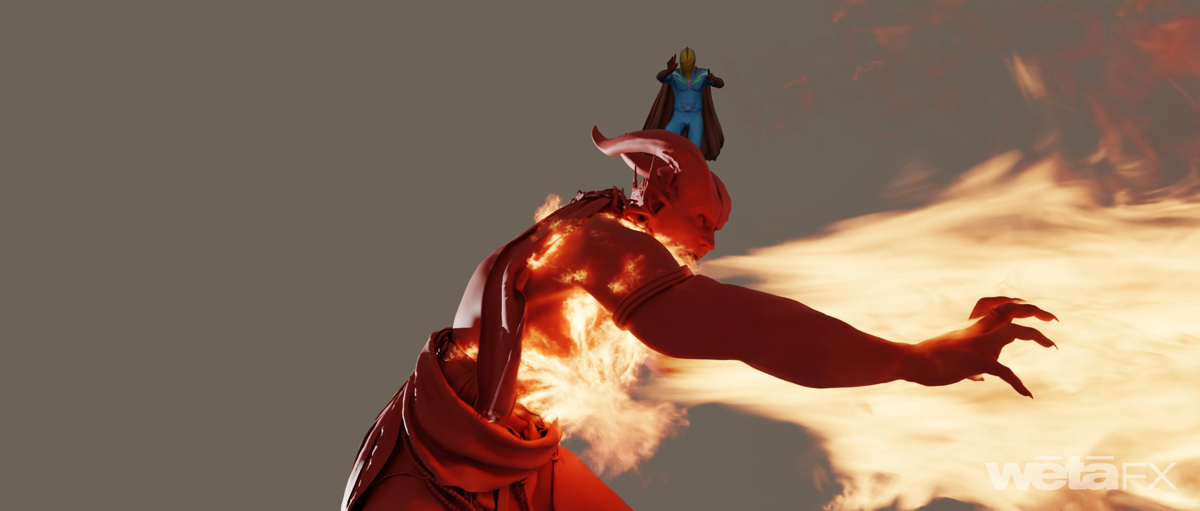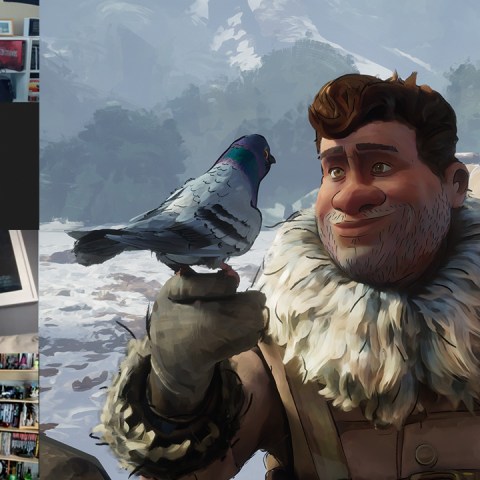(It came as somewhat of a surprise to the VFX team behind it, too)
OK, it’s a major Black Adam spoiler, but the climactic battle between Black Adam (Dwayne Johnson) and Sabbac (Marwan Kenzari) eventually results in the devilish, lava-filled villain– i.e. Sabbac–being ripped apart into two pieces.
It’s an intense sequence in the film, realized thanks to visual effects from Wētā FX. Incredibly, the VFX studio only learned about Sabbac’s final moments when live-action filming of the scene was taking place.
“The splitting was actually a bit of a surprise to all of us,” recounts Wētā FX visual effects supervisor Sheldon Stopsack, who worked with production VFX supervisor Bill Westenhofer on the film.
“For a long period of time we were working on the movie, on the third act, and Sabbac’s end was always a little bit of ‘unfinished business’,” details Stopsack. “Director Jaume Collet-Serra was always pushing us and looking for new ideas. He would say, ‘How can we create a really powerful finale that the villain really deserves?’”
“The splitting scene came together during additional photography in Atlanta. Up until that point, no one knew that Sabbac was going to be split in half,” relates Stopsack. “All of a sudden, there was this previs that popped up out of the blue.”


“It came a little unexpectedly, but it was a very powerful thing, and I remember us all watching it and wondering ‘How are we going to do that?’ But then the more we looked at it and thought about it, we agreed it was a very appropriate way of killing Sabbac off, as it gave Black Adam his moment of strength.”
So how did Wētā FX do the split? Well, Sabbac was of course a digital character, informed by the on-set and captured performance of Kenzari (more on that below). But to do the actual split, the visual effects company treated the character as if it were actually two.
“We thought of it almost like a decapitation,” explains Stopsack. “If I split something in half, I actually have two characters, two Sabbacs. And in many ways, it was almost like we animated two Sabbacs, without initially caring too much about the split. The animation team had these two halves that they could independently manoeuvre and manipulate the way they wanted.”
With the two individual pieces of animation, the studio could then impose that onto one coherent mesh of their CG Sabbac, with the FX team then adding to the character with ripping and tearing of tissue.
“Also,” says Stopsack, “the concept of Sabbac being a devil-like, lava-filled, fire being helped us in two ways. Firstly, it allowed us to stay on character because as he was ripping apart, we stayed in this sort of fire language or lava language that we had established early in the movie.”
“Secondly, it helped us with disguising the ‘PG’ rating concerns. As soon as you rip a humanoid character into two, you run the risk of showing things that you may not want to or that ratings may not necessarily allow. So we leaned into the idea of filling him up with lava that has this viscous quality, which spills out and helps to disguise some of the gore.”
Before the splitting of Sabbac: the shaping of Sabbac
On set, Kenzari (and stunt performers) wore a faux-cap suit used for body tracking. Sabbac’s build is taller than the actor and includes horns, a gaunt body shape and devil- like features, “but we still wanted to carry through the subtleties and performance from Marwan to Sabbac,” notes Stopsack.


For facial capture, the actor wore a stereo head-mounted camera from Technoprops with markers drawn on his face. “We went to town building up a full-blown facial system that could be derived by the facial performance,” outlines Stopsack, “including going through the step of using the deep shapes that we’d created for Gemini Man to get all these extra subtleties. We processed the data through our deep learning solver (DLS) which resulted in animation curves derived from Marwan’s facial performance that we then translated onto Sabbac.”
One challenge of Sabbac’s final look was his red skin. Stopsack says the character’s internal ‘fire inside’ gave the skin color a clear linkage, but it did pose hurdles in a different way.
“What it didn’t allow for is the same sort of trickery that you would normally lean into for a CG human character, like blushing or straining to convey subtle emotion. But then, his internal glow definitely helped a lot ,because it gave him a sort of menacing appearance.”
With many action beats to meet, and several super close-ups of the character required, Wētā FX built their CG Sabbac in high detail. They were even asked by production at one point to produce marketing renders of Sabbac at what was effectively 10K.
“One of our CG supes, Ben Campbell, ended up taking on the task to render him in 10K,” discusses Stopsack. “Ben actually described it as the asset getting better and better and better. Normally, if you render something at 10K, all of a sudden you see all of the details that you didn’t quite figure out.”
“But when we rendered Sabbac,” adds Stopsack, “and looked closely at every single aspect of his build, whether it was the nails, the nail beds, or any feature on his face, or the skulls embedded in his back surrounded by the sooty, charring texture–every detail was absolutely glorious and beautiful. That gave us the confidence to really chuck him into any shot context, as we just knew he would work.”



























